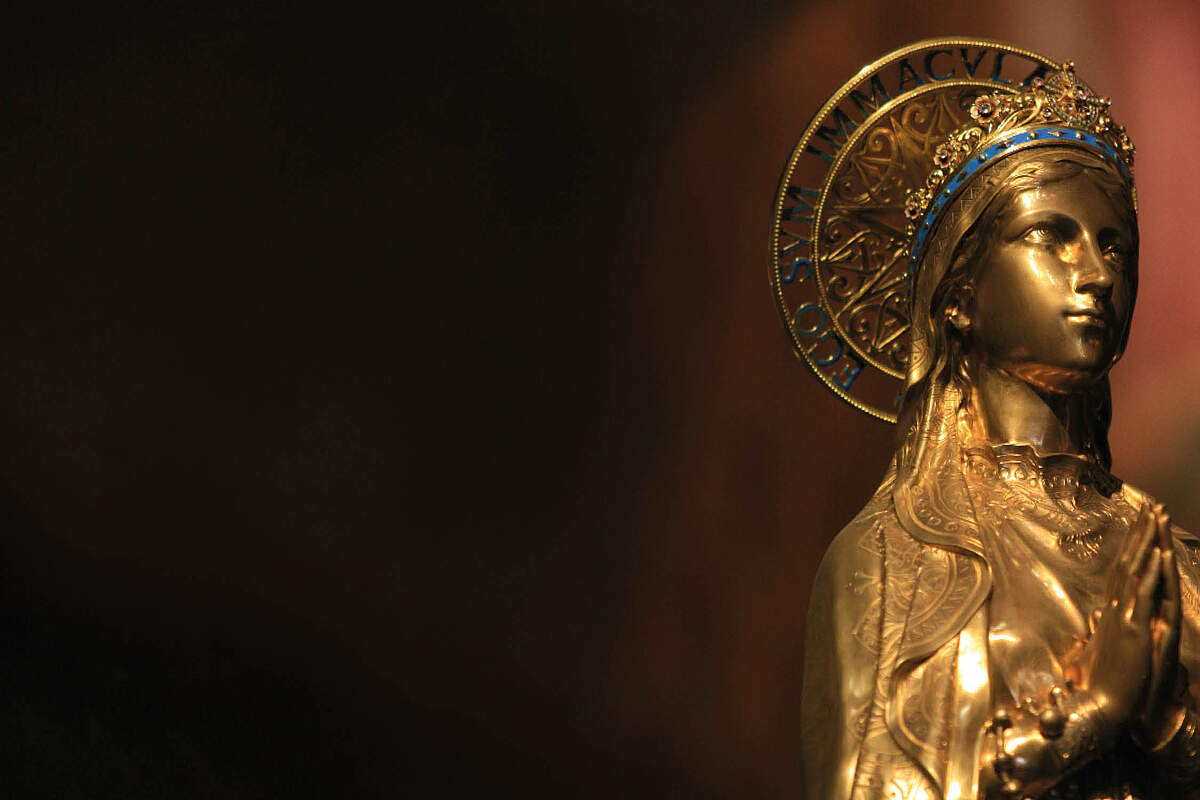
The Immaculate Conception is the conception of the Most Holy Virgin Mary “without any stain”, in other words, free from original sin. Mary was, from her very origin, completely devoid of sin. In each of her apparitions (Marian apparitions) the Immaculate Conception thus shines forth goodness, light and grace.
Sign up to the novenas' newsletter
For many people, the “Immaculate Conception” means that Mary became the Mother of Jesus thanks to the Holy Spirit, without carnal relationship with Joseph. However, as the Christian faith assures us, the conjugal relationship is not in itself a sin: “If marriage were a sin, it could not be a sacrament […]”, Mgr. Jacques Perrier, Bishop Emeritus of Tarbes and Lourdes reminds us. Throughout history Christians have venerated the Virgin Mary. She is represented in the catacombs, in 431 she is recognized as the Mother of God at the Council of Ephesus (currently Turkey), a fully saintly Mother who remained untouched by sin. The lack of a dogmatic definition has not prevented Christians from celebrating the conception of Mary without sin: The immaculate conception, inspired by the account of the Annunciation; Mary is the woman “full of grace” (Lk. 1: 28).
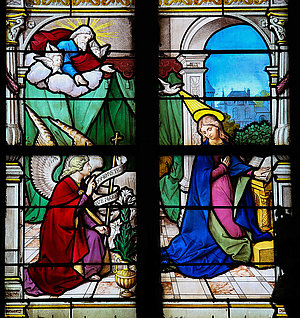
Why was the Virgin Mary conceived without sin?
“The Immaculate Conception of Mary does not concern the past but the future”, as Mgr. Perrier, Bishop Emeritus of Tarbes and Lourdes explains:
“The Virgin Mary is preserved from any trace of sin so as that she can fulfill the mission God wishes to entrust to her: That of becoming the Mother of the Son, of the Savior of his people and of Humanity. Accepting to become the virgin Mother of the Son of God requires a faith of which no one, in the Old Testament, was ever capable. It calls for total liberty, not with a liberty of indifference, but a liberty of giving of oneself, which makes it possible to say “yes” to that which surpasses us”.
To welcome the Savior, Mary could not hold in her heart the slightest trace of hesitation or rejection. God required that the gift of his love should find a perfectly pure faith, a soul without sin; that is why Mary is the Immaculate Conception.
In December, we invited you to pray a beautiful novena to the Immaculate Conception, written by Mgr. Perrier who explains:
“When we recite the Rosary, we meditate, decade after decade, on a moment of the life of Christ. Often, the Virgin Mary is involved in it, particularly in the joyful mysteries. We can, in a way, form a mental picture of the scene, as painters have often done. Even the Assumption of Mary can be imagined, by analogy, with the Ascension of Jesus. But the Immaculate Conception? We have no support for our prayer. Besides, there is no decade devoted to this mystery of the Immaculate Conception.”
The feast day has been celebrated in Rome since 1477 and, in 1854, Pope Pius IX established, on the occasion of the proclamation of the dogma of the Immaculate Conception that “the Most Blessed Virgin Mary at the first moment of her conception was, by singular grace and privilege of the Omnipotent God, in virtue of the merits of Jesus Christ, Savior of the Human race, preserved from all stains of original sin”.
Less than four years after the solemn proclamation of this dogma of the Immaculate Conception in Saint Peter’s Basilica, a Beautiful Lady, appearing for the sixteenth time to Bernadette Soubirous, finally revealed her name to her: “I am the Immaculate Conception”. It was March 25th, 1858, on the feast of the Annunciation. The bishop of the area recognized the authenticity of the apparitions, without declaring them an article of faith. Towards the end of her life, Bernadette wrote to the Pope, who was still Pius IX:
“I think the Holy Virgin is kind. It is as if she had come to confirm the word of our Holy Father.”
This novena to the Immaculate Conception was available online (you could have received it for free by email) from November 30th to December 7th, on the eve of the feast of the Immaculate Conception.
To learn about our incoming novenas, sign up here.
Sign up to the novenas' newsletter
What does the celebration of the Immaculate Conception mean?
The Immaculate Conception is celebrated by the Catholic Church on December 8th, at the beginning of Advent, nine months to the day, before the feast of the Nativity of the Virgin Mary, held on September 8th. The feast of the Immaculate Conception has been celebrated in Rome since 1477. (Cette phrase est une repetition; voir plus haut…) Although the Orthodox Church celebrates the feast of the Conception of Mary and calls Mary “the Immaculate”, it does not, however, recognize this dogma of the Immaculate Conception, together with Protestants and the other Christian churches.
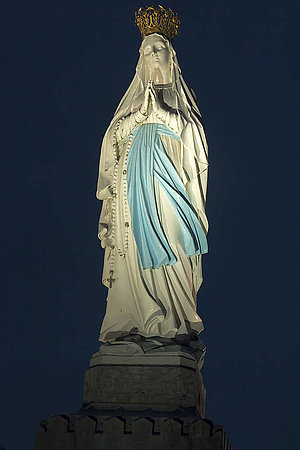
A dogma is a truth of faith solemnly proclaimed by the Pope for its acceptance by the Church. The dogma of the Immaculate Conception is a dogma of the Catholic Church which was proclaimed on December 8th, 1854 by Pope Pius IX in the Bull Ineffabilis Deus; however, this belief was already held by certain Fathers of the Church. It is often mistakenly confused with that of the virginal conception of Jesus-Christ, in other words, with the dogma of the Incarnation, but it relates only to the conception of Mary herself. Therefore, on December 8th, 1854, in the Bull Ineffabilis Deus, the Pope Pius IX stated:
“We declare, pronounce, and define that the doctrine which holds that the most Blessed Virgin Mary, in the first instance of her conception, by a singular grace and privilege granted by Almighty God, in view of the merits of Jesus Christ, the Savior of the human race, was preserved free from all stain of original sin, is a doctrine revealed by God and therefore to be believed firmly and constantly by all the faithful.”
In order to declare the dogma of the Immaculate Conception, the Pope did not summon an ecumenical council, as in the case of the Council of Nicea, in the fourth century, which led to the formulation of the Creed. But the Pope did not act alone.
In 1849, he launched a consultation among all the bishops of the world, in order to enquire, in their respective dioceses, about “the feeling of the clergy and the people with regard to the conception of the Immaculate Virgin”. He also wanted to know whether the bishops “wished that the question be settled by the apostolic see”. The consultation was extended to the faculties of theology. The formulation of the dogma itself is at the heart of a development which explains how the Church gains the awareness of not inventing anything but of simply sanctioning a long tradition rooted in the preaching of the Gospel. In the few lines of the definition, it is worth underlining two aspects: Christ is, indeed, the Savior of all Humanity, including Mary, even though, in her case, this occurs in advance. On the other hand, sin leaves traces, wounds, from which Mary was also preserved. The Pope chose the 8th of December as the date for the proclamation, nine months before the day on which, from a long time back, the Nativity of the Virgin was celebrated.
The Pope confided to a religious what he experienced on that day:
“While God proclaimed the dogma through the mouth of His Vicar, God Himself gave me an inner certainty so clear and so vast of the incomparable purity of the Most Holy Virgin that, overwhelmed by the abyss of this awareness which no language could describe, my soul remained filled with inexpressible delight, a delight from out of this world and which one could only experience in Heaven.” (Dom Xavier Perrin, “Regards sur l’Immaculée”, [T.N.: “Gazing Upon the Immaculate”], Éditions du Carmel).
Although this form of speech is no longer entirely in keeping with our times, this novena to the Immaculate Conception would seek seeks to make us experience something of the Pope’s emotion before the mystery of the Immaculate Conception.
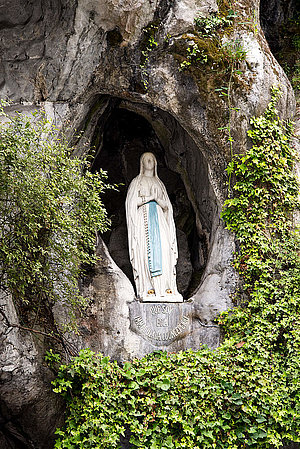
The apparitions of Lourdes occurred less than four years after the solemn proclamation of the dogma of the Immaculate Conception by Pope Pius IX. On March 25th, 1858, “a little young lady” appeared to Bernadette Soubirous, only just 14 years old, on February 11th, 1858, at the grotto of Massabielle. The apparitions occurred, one after another, particularly during the fortnight between February 18th and March 4th. The apparition finally revealed her name: “I am the Immaculate Conception.”
Only after sixteen apparitions did the Virgin Mary disclosed her name to Bernadette in Lourdes, in 1858. However, Bernadette said “yes” immediately, in full confidence, without knowing the identity of her messenger. It is not by chance that the Lady revealed her identity on March 25th, the day of the Annunciation. It is on that day that the Angel called Mary and, precisely, he did not call her “Mary” but “full of grace”, as we word it. The Greek in the Gospel is untranslatable. We can try: “Masterpiece of grace”, a form of speech that is unique in the Scripture. Mary is the only one who God addresses in this manner. She is The Immaculate Conception, preceded by the definite article “the”, because she is the only one. Just as Christ is the only one to be the Way, the Truth and Life. The popes, without canonizing the words heard and repeated by Bernadette, also consider that Lourdes echoes the proclamation of the dogma. That is why, when mentioning the Marian shrines throughout the world, they always place Lourdes at the head of the list. Particularly, that is why:
Holy and Immaculate Virgin,
to you who are the honor of our people
and the attentive guardian of our city,
we have recourse with confidence and love.
You are the Most Beautiful, oh Mary!
Sin does not dwell in you
Kindle in us all a renewed desire of sainthood:
May the splendor of truth shine in our words,
may the song of charity resound in our deeds,
may purity and chastity inhabit our bodies and hearts,
may all the beauty of the Gospel be present in our lives.
You are the Most Beautiful, oh Mary!
God’s Word became flesh in you.
Help us to remain in attentive listening to the voice of the Lord:
May the cry of the poor never leave us indifferent,
may the suffering of the sick and needy not find us distracted,
may the solitude of the elderly and the frailty of children stir us,
may every human life always be loved and revered by us all.
You are the Most Beautiful, oh Mary!
In you is the perfect joy of the beatific life with God.
Help us not lose the sense of our path on Earth:
May the sweet light of faith shine upon our days,
may the consoling strength of hope guide our steps,
may the contagious warmth of love kindle our hearts,
may our eyes remain firmly set there, on God, in whom we find true joy.
You are the Most Beautiful, oh Mary!
Listen to our prayer, grant us that which we plead:
May the beauty of the merciful love of God in Jesus be in us,
may this divine beauty save us, save our city, save the whole world.
Amen.
When the Virgin Mary appeared to Catherine Labouré at rue du Bac, Paris, in 1830, the Virgin presented herself as “conceived without sin”. Indeed, between 1830 and 1831, Sister Labouré was to receive, during three visions of the Virgin, the revelation of her mission. On November 27th, 1830, during her second apparition: The Immaculate Virgin stands with outstretched arms and from her hands are cast luminous rays. “These rays symbolize the graces that Mary obtains for people”, a voice utters. To people who ask for them… because, during the third and last apparition, in December of that same year, the Immaculate Conception specifies, in relation to certain rays which remain dim when issuing from her fingers:
“These are the graces which people forget to ask of me.” On January 30th, 1831, Catherine pronounces her vows and takes on the habit of the Daughters of Saint Vincent. Only her confessor knows her secret, as the Immaculate Virgin asked her to remain anonymous until the end. The Virgin Mary also requested that a medal be coined, representing the second vision, and bearing these words: “Oh Mary, conceived without sin, pray for us who have recourse to thee.”
A great many churches throughout the world are dedicated to the Immaculate Conception. In art, the Immaculate Conception is the theme of a significant amount of iconography, either in paintings or, particularly, in sculpture. Well known paintings are The Immaculate Conception of Los Venerables by Murillo or that by Diego Velazquez, in 1618. The Immaculate Conception is also the Patroness of Portugal, Spain, United States, Korea, Philippines, Nicaragua, El Salvador and Corsica.
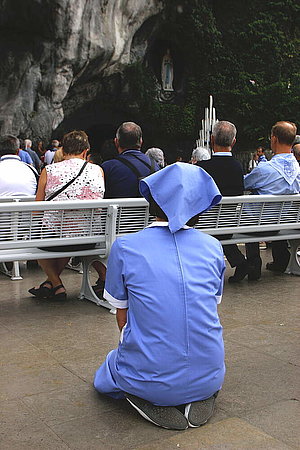
In 1965, three years before his death, Padre Pio asked one of his spiritual daughters to present a bunch of flowers, on December 8th, the solemnity of the Immaculate Conception, in his name and that of the sick of the Casa Sollievo Della Sofferenza of Saint Giovanni Rotondo (Italy), at the foot of the statue of the Immaculate at Piazza Di Spagna in Rome. Since that date, many Padre Pio Prayer Groups congregate every December 8th for a Mass in the Sant’Andrea delle Fratte basilica in Rome, to then continue, in procession, to place one of the flowers at the foot of this statue, just as the Holy Father and many Romans do. Reviving, on their own, the request of their founding saint, the Padre Pio Prayer Groups of Paris adopted the initiative, on December 8th, 2015 (50 years after his request), and again in the ensuing years, of taking flowers to the foot of the statue of the Immaculate Conception in Lourdes, the very place where, on March 25th, 1858, the Apparition revealed her name to Bernadette Soubirous: “I am the Immaculate Conception”.
In order to perpetuate the Lourdes floral homage, it was decided that, as from 2017, this should no longer be organized only by the Padre Pio Prayer Groups but by the “Our Lady of Lourdes Family” (to which the Padre Pio Prayer Groups belong) and to allow devotees of the Immaculate Conception to offer her a rose, even through Internet.